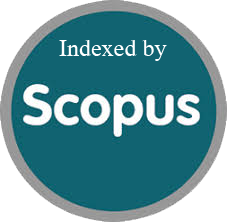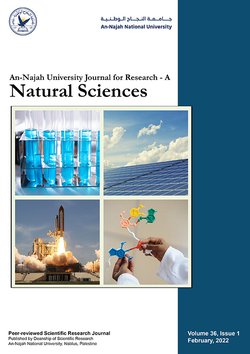Advanced Oxidation of Organic Dyes Using a Porous Gold Electrode: Kinetic Analysis
Authors:
Article info
2025-03-07
2025-04-20
2025-04-24
None - None
Keywords
Abstract
MAX 250 words This study evaluates the efficiency of anodic oxidation processes for the degradation of the azo dye Reactive Blue 203 (RB203) using a gold electrode in an compartmented electrochemical cell. Unlike most studies that rely on conventional electrodes such as BDD or graphite, this work explores the use of a porous gold electrode—an uncommon yet promising material in dye degradation—highlighting its high electrocatalytic activity and exceptional chemical stability. Experiments explored the effects of current density, initial pH and type of supporting electrolyte. The gold electrode performed remarkably well, achieving a 91.82% decolorization rate and 96% Chemical Oxygen Demand (COD) removal after 360 minutes of treatment. Best performance was observed under acidic conditions (pH = 3), where the formation of hydroxyl radicals (●OH) is favored. The use of KCl as a supporting electrolyte improved degradation compared to Na₂SO₄, thanks to better ionic conductivity and the generation of reactive species such as Cl₂ and HOCl. Kinetic analysis revealed that the reaction follows a pseudo-first-order model, with rate constants increasing from 0.00261 min-¹ to 0.0141 min-¹ as the current density increases from 100 to 400 mA.cm-². These results confirm that anodic oxidation, with the gold electrode, is an effective and sustainable method for treating textile wastewater
Zaaboul, F., Haoufazane, C., Ouardi, M. E., Abouri, M., Azzaoui, K., Hammouti, B., Kartah, B. E., Kartah, B. E., Jodeh, S., & Hourch, A. E. (2025). Advanced Oxidation of Organic Dyes Using a Porous Gold Electrode: Kinetic Analysis. An-Najah University Journal for Research - A (Natural Sciences), 40(1). https://doi.org/10.35552/anujr.a.40.1.2476
[1]F. Zaaboul et al., “Advanced Oxidation of Organic Dyes Using a Porous Gold Electrode: Kinetic Analysis,” An-Najah University Journal for Research - A (Natural Sciences), vol. 40, no. 1, Apr. 2025, doi: 10.35552/anujr.a.40.1.2476.
Zaaboul, Fatima, et al. “Advanced Oxidation of Organic Dyes Using a Porous Gold Electrode: Kinetic Analysis.” An-Najah University Journal for Research - A (Natural Sciences), vol. 40, no. 1, Apr. 2025. Crossref, https://doi.org/10.35552/anujr.a.40.1.2476.
1.Zaaboul F, Haoufazane C, Ouardi ME, Abouri M, Azzaoui K, Hammouti B, et al. Advanced Oxidation of Organic Dyes Using a Porous Gold Electrode: Kinetic Analysis. An-Najah University Journal for Research - A (Natural Sciences) [Internet]. 2025 Apr;40(1). Available from: http://dx.doi.org/10.35552/anujr.a.40.1.2476
Zaaboul, Fatima, Chaimaa Haoufazane, Mohamed EL Ouardi, Meryem Abouri, Khalil Azzaoui, Belkheir Hammouti, Badr Eddine Kartah, Badr Eddine Kartah, Shehdeh Jodeh, and Abderrahim El Hourch. “Advanced Oxidation of Organic Dyes Using a Porous Gold Electrode: Kinetic Analysis.” An-Najah University Journal for Research - A (Natural Sciences) 40, no. 1 (April 2025). https://doi.org/10.35552/anujr.a.40.1.2476.
Advanced Oxidation of Organic Dyes Using a Porous Gold Electrode: Kinetic Analysis
المؤلفون:
معلومات المقال
2025-03-07
2025-04-20
2025-04-24
None - None
الكلمات الإفتتاحية
الملخص
MAX 250 words This study evaluates the efficiency of anodic oxidation processes for the degradation of the azo dye Reactive Blue 203 (RB203) using a gold electrode in an compartmented electrochemical cell. Unlike most studies that rely on conventional electrodes such as BDD or graphite, this work explores the use of a porous gold electrode—an uncommon yet promising material in dye degradation—highlighting its high electrocatalytic activity and exceptional chemical stability. Experiments explored the effects of current density, initial pH and type of supporting electrolyte. The gold electrode performed remarkably well, achieving a 91.82% decolorization rate and 96% Chemical Oxygen Demand (COD) removal after 360 minutes of treatment. Best performance was observed under acidic conditions (pH = 3), where the formation of hydroxyl radicals (●OH) is favored. The use of KCl as a supporting electrolyte improved degradation compared to Na₂SO₄, thanks to better ionic conductivity and the generation of reactive species such as Cl₂ and HOCl. Kinetic analysis revealed that the reaction follows a pseudo-first-order model, with rate constants increasing from 0.00261 min-¹ to 0.0141 min-¹ as the current density increases from 100 to 400 mA.cm-². These results confirm that anodic oxidation, with the gold electrode, is an effective and sustainable method for treating textile wastewater
Zaaboul, F., Haoufazane, C., Ouardi, M. E., Abouri, M., Azzaoui, K., Hammouti, B., Kartah, B. E., Kartah, B. E., Jodeh, S., & Hourch, A. E. (2025). Advanced Oxidation of Organic Dyes Using a Porous Gold Electrode: Kinetic Analysis. An-Najah University Journal for Research - A (Natural Sciences), 40(1). https://doi.org/10.35552/anujr.a.40.1.2476
[1]F. Zaaboul et al., “Advanced Oxidation of Organic Dyes Using a Porous Gold Electrode: Kinetic Analysis,” An-Najah University Journal for Research - A (Natural Sciences), vol. 40, no. 1, Apr. 2025, doi: 10.35552/anujr.a.40.1.2476.
Zaaboul, Fatima, et al. “Advanced Oxidation of Organic Dyes Using a Porous Gold Electrode: Kinetic Analysis.” An-Najah University Journal for Research - A (Natural Sciences), vol. 40, no. 1, Apr. 2025. Crossref, https://doi.org/10.35552/anujr.a.40.1.2476.
1.Zaaboul F, Haoufazane C, Ouardi ME, Abouri M, Azzaoui K, Hammouti B, et al. Advanced Oxidation of Organic Dyes Using a Porous Gold Electrode: Kinetic Analysis. An-Najah University Journal for Research - A (Natural Sciences) [Internet]. 2025 Apr;40(1). Available from: http://dx.doi.org/10.35552/anujr.a.40.1.2476
Zaaboul, Fatima, Chaimaa Haoufazane, Mohamed EL Ouardi, Meryem Abouri, Khalil Azzaoui, Belkheir Hammouti, Badr Eddine Kartah, Badr Eddine Kartah, Shehdeh Jodeh, and Abderrahim El Hourch. “Advanced Oxidation of Organic Dyes Using a Porous Gold Electrode: Kinetic Analysis.” An-Najah University Journal for Research - A (Natural Sciences) 40, no. 1 (April 2025). https://doi.org/10.35552/anujr.a.40.1.2476.

Since 2019
Cite Score (Scopus): 0.8
Time to First Decision: 5 Days
Submission to Acceptance: 90 Days
Acceptance to Publication: 14 Days
Acceptance Rate: 22%
Call for Papers:
Sustainable Materials and Chemistry for Energy and Environmental Applications
Why should you
Publish With Us?
An-Najah National University
Nablus, Palestine
Nablus, Palestine
- P.O. Box
- 7, 707
- Fax
- (970)(9)2345982
- Tel.
- (970)(9)2345560
- (970)(9)2345113/5/6/7-Ext. 2628
- [email protected]
- EIC
- Prof. Waleed Sweileh
An-Najah University Journal for Research - A (Natural Sciences) by An-Najah University, Nablus, Palestine is licensed under CC BY-NC 4.0

